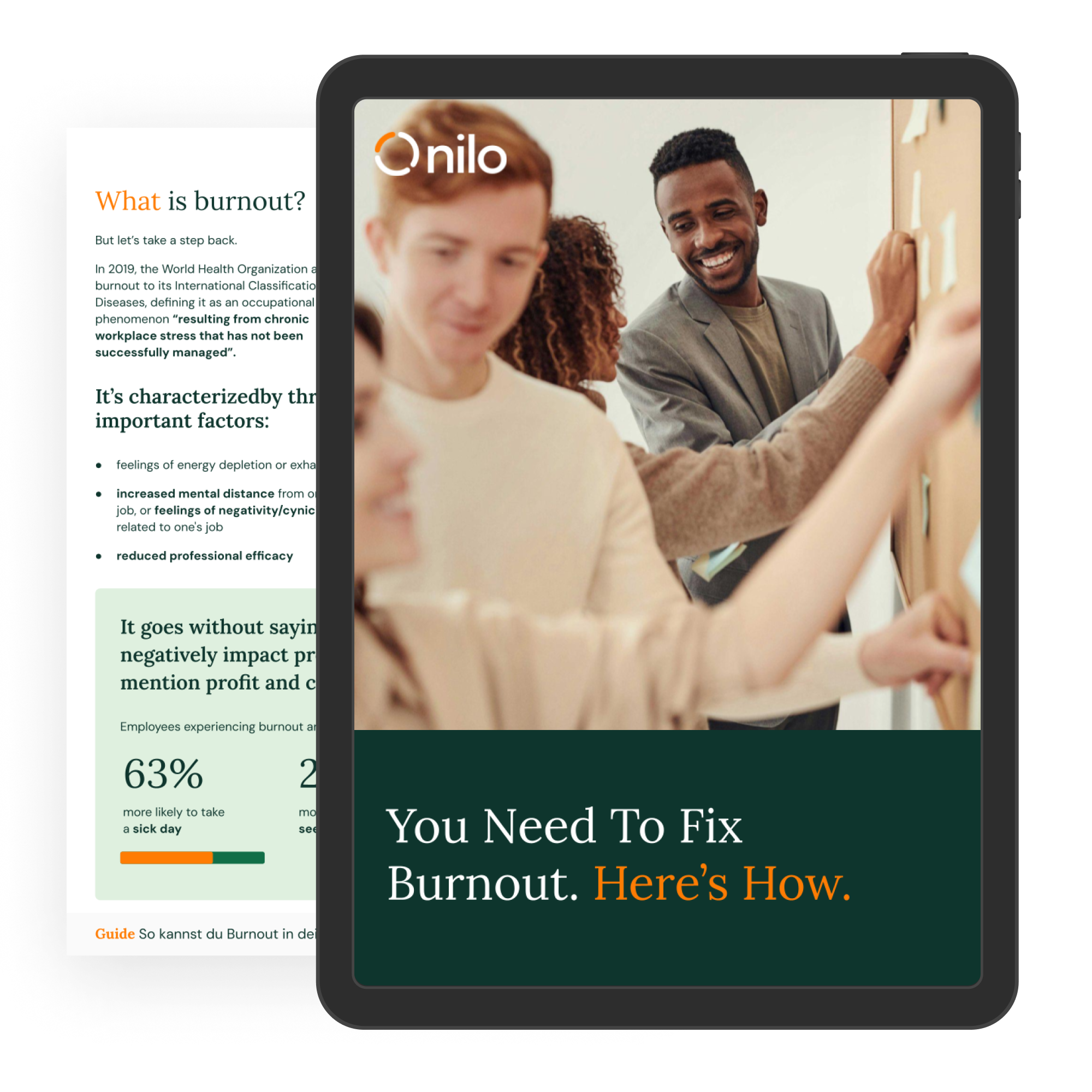Leaders are under constant pressure – making them especially prone to burnout. Yet in many organizations, burnout at the leadership level is still a taboo subject. This needs to change. Recent figures show a clear trend: the pressure on executives is steadily increasing.
In this article, we’ll explore why leadership burnout is far from a rare occurrence, which signs and symptoms should be recognized early, and what measures can effectively prevent burnout among leaders.
Why Leadership Burnout Deserves Serious Attention
Burnout among leaders is no longer the exception – it’s increasingly the norm. In fact, executives are particularly vulnerable to mental exhaustion, often resulting in extended absences. According to Statista, in 2023, leadership roles accounted for the highest number of burnout-related sick days.
The consequences are far-reaching:
- Economic: Burnout leads to poor decision-making, reduced productivity, and the long-term loss of key personnel.
- Personal: Affected individuals face psychosomatic symptoms, emotional exhaustion, and social withdrawal.
- Organizational: Perhaps most critically, when leaders burn out, it directly impacts teams, employee morale, and day-to-day operations.
This makes it all the more important to take leadership burnout prevention seriously – and to act before the damage is done.
Causes of Leadership Burnout: Where Pressure Builds Up
The risk of burnout rises significantly when multiple stressors converge – a situation that’s especially common in leadership roles. Executives are expected to deliver on strategic goals while also managing day-to-day operations. Yet in many organizations, they lack the necessary resources, clear responsibilities, or peer support to navigate this dual pressure effectively.
When personal traits like perfectionism meet structural shortcomings within the organization, a dynamic emerges that often leads to chronic exhaustion over time.
The following factors are known to contribute to leadership burnout – and they rarely act alone. Instead, they tend to reinforce one another and create a cycle of ongoing strain.
Work-Related Factors
- High performance pressure and constant availability
Leaders operate under ongoing pressure to perform. Targets, budgets, and the expectation to respond quickly and competently are part of everyday life. At the same time, the line between work and personal life is increasingly blurred. Constant accessibility prevents recovery and significantly increases mental strain. - Caught between team and top management
Leaders often find themselves in a “sandwich position” – balancing the demands of upper management with the needs of their own team. The pressure to deliver results while also fostering a healthy team environment creates ongoing tension. This role conflict, often marked by conflicting expectations, leads to inner stress and emotional fatigue. - Lack of appreciation
Despite their responsibilities and efforts, many leaders feel undervalued. Recognition, praise, or even honest feedback are often missing in their day-to-day. When the only feedback comes in the form of criticism, emotional exhaustion tends to grow.
Personal Factors
- Perfectionism
Many leaders set extremely high standards for themselves. Mistakes are seen as flaws, and showing vulnerability is avoided – often out of fear of appearing weak or unprofessional. As a result, rest is interpreted as weakness, and personal needs are consistently ignored. This mindset undermines self-care and is further reinforced by the ongoing stigma around mental health. - Difficulty setting boundaries
Highly committed leaders often “burn bright” – until they burn out. Strong identification with their role, combined with a desire to always be available, leads to chronic overextension. Without clear boundaries between work and rest, recovery becomes impossible. - Neglect of self-care
Regular breaks, physical activity, healthy eating, or maintaining social connections – all of these often take a back seat to deadlines and responsibility. Yet self-care isn’t a luxury; it’s essential for long-term resilience and performance.
Organizational Factors
- Toxic culture and lack of psychological safety
Cultures that prioritize performance above all else, where mistakes are taboo and openness is missing, are a breeding ground for burnout. Without psychological safety, leaders don’t feel they can show vulnerability – ultimately undermining their health and motivation. - Lack of support
Many leaders lack genuine support from within the organization. Peer-level sparring, trusted spaces for exchange, or tailored coaching are often missing. Without this framework, the feeling of being left alone with challenges grows – increasing stress levels significantly. - Unclear roles and responsibilities
Ambiguity around tasks, decision-making authority, and expectations leads to constant insecurity. Leaders get caught in role conflicts, must cover gaps, and are forced to renegotiate priorities on the fly.
Recognizing the Signs of Leadership Burnout
Burnout is defined in the WHO’s ICD-11 as an occupational phenomenon – not a medical condition per se, but the result of chronic workplace stress that has not been successfully managed. It is characterized by three key dimensions: emotional exhaustion, mental distancing from one’s job, and a noticeable decline in performance.
In leadership roles, burnout often develops gradually and remains unnoticed for a long time. That makes it all the more important to recognize early warning signs in leaders:
Physical Symptoms
- Persistent fatigue despite rest and recovery
- Sleep disturbances or restless sleep
- Frequent headaches, back pain, or stomach issues
Emotional Symptoms
- A sense of inner emptiness
- Irritability and emotional instability
- Depressive moods or lack of drive
Cognitive and Performance-Related Symptoms
- Difficulty concentrating and reduced attention span
- Declining motivation
- Lower productivity in everyday tasks
Social Symptoms
- Withdrawal from team activities and meetings
- Increasing cynicism or emotional detachment
- Feelings of hopelessness and disengagement
These warning signs should never be ignored – especially if they persist or intensify over several weeks. Early recognition is the first and most important step toward intervention and recovery.
3 Steps to Prevent Leadership Burnout
To prevent burnout from taking hold in the first place, early and targeted action is essential. For leaders, prevention means actively strengthening mental resilience – through clear routines, healthy structures, and a mindset that values recovery just as much as performance.
At the heart of effective prevention lies the balance between personal self-leadership and an organizational culture that promotes mental well-being. Leaders who take care of themselves and operate in a supportive environment not only stay productive – they also provide stability for their teams.
The following approaches show how burnout prevention can work in practice.
Self-Management and Self-Care
One of the most important pillars of leadership burnout prevention is effective self-management. This includes setting realistic priorities, structuring the workday clearly, and making conscious decisions about what truly matters. Scheduled breaks and recovery time deserve the same priority as business meetings.
Work-life balance should not be the first thing to fall by the wayside when things get busy. Self-care is not a weakness – it’s a core leadership skill. That said, the responsibility doesn’t lie with individuals alone. Organizations must also provide the structures and conditions that enable sustainable and healthy ways of working.
Company Culture and Psychological Safety
Company culture is a crucial factor in preventing leadership burnout. An open communication culture enables leaders to speak up about pressure and challenges – without fear of judgment or negative consequences.
At the core of this is psychological safety: a work environment where feedback, uncertainty, and even mistakes can be shared openly without putting one’s status at risk. Leaders need safe spaces where they can name difficulties and work through them collaboratively. A strong sense of team cohesion also plays a key role in building resilience.
A well-established feedback culture – one that values recognition as much as critique – further contributes to emotional stability. Making appreciation visible is a powerful lever for motivation and mental well-being.
Resources & Tools
Beyond self-care and supportive work culture, targeted resources and tools play a key role in preventing leadership burnout.
Professional coaching or mentoring offers space for reflection and personal growth – often exactly what gets lost in the daily grind. Workshops and training sessions on topics like stress management, resilience, or mental health help leaders build stronger self-awareness and coping strategies. Peer exchange creates new perspectives and helps regain clarity.
Digital platforms like nilo provide flexible formats for self-reflection and resilience building. Particularly valuable: the low-threshold access to licensed psychologists directly integrated into the platform.
How to Support Leaders Through Burnout
When a leader experiences acute burnout, timely and thoughtful action from HR is essential. Structured, compassionate support can help prevent long-term consequences and lay the groundwork for sustainable recovery. The following steps provide a practical roadmap:
1. Recognize the warning signs
Persistent exhaustion, social withdrawal, cynicism, or a noticeable drop in performance are common red flags. HR should be trained to identify these symptoms early and not dismiss them as temporary lapses.
2. Initiate a conversation
A confidential, empathetic conversation is often the most important first step. Depending on the situation, it may be wise to involve a mental health professional for an initial assessment or to help facilitate next steps.
3. Provide immediate relief
To reduce acute pressure, HR and leadership can work together to implement short-term relief. For example, a temporary leave, a sabbatical, or a redistribution of responsibilities within the leadership team.
4. Organize professional support
Lasting recovery requires external help. HR should actively promote access to therapy, psychological counseling, or coaching. Digital platforms focused on resilience and stress management can also play an important role in ongoing support.
These steps form the foundation for effective burnout intervention – and help leaders return with clarity, capacity, and confidence.
Conclusion: Burnout Is a Warning Sign – Not a Personal Failure
Burnout is not a sign of weakness. It’s a clear signal that something is out of balance. For leaders, it’s crucial to take this signal seriously – both for their own well-being and as role models within the organization. Companies, in turn, must create structures and a culture that support health, resilience, and sustainable leadership.
FAQ
How do I talk about burnout as a leader?
Start with clear and honest communication. Name your exhaustion without apologizing for it. Statements like “I’ve reached my limit” or “I need support to stay effective in the long run” create understanding and accountability. It also helps to suggest concrete next steps – such as taking a break, starting coaching, or delegating certain responsibilities. Speaking up isn’t a weakness – it’s a sign of responsibility.
How can I prevent burnout as a leader?
Prevention starts with self-leadership: structure your day, prioritize tasks, and build in time for recovery. Self-care also means setting boundaries – for example, defining working hours or taking conscious breaks. Just as important is creating a psychologically safe environment: foster open communication, encourage feedback, and support one another as a team. Leadership isn’t just about driving performance – it’s about shaping conditions that enable people to thrive.
What impact does burnout have on leaders?
Burnout affects more than just energy levels. It can diminish leadership quality, erode trust within the team, and lead to extended absences – all with serious consequences for the organization. That’s why early intervention is critical – not just for personal health, but for long-term business stability.
Why is preventing leadership burnout so important?
Leaders have a disproportionate influence on team dynamics, culture, and performance. Their behavior sets the tone for how stress and change are handled across the company. When a leader is overwhelmed, it affects the whole team – often leading to demotivation, turnover, and tension. Preventing leadership burnout isn’t just about protecting individuals – it’s a strategic investment in the organization’s future.








